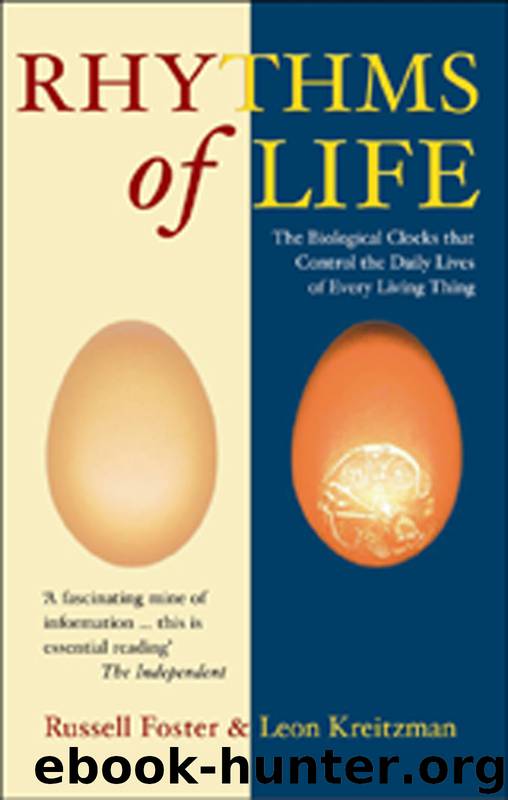The Rhythms of Life by Leon Kreitzman & Leon Kreitzman

Author:Leon Kreitzman & Leon Kreitzman
Language: eng
Format: epub
Publisher: Profile Books Ltd
Published: 2004-03-14T16:00:00+00:00
Figure 9.2. (A) The effect of 15-minute light-breaks on the rate of testicular growth in Japanese quail maintained under a six-hour photoperiod. (B) Diagram showing the time of the 15-minute pulse of light. From Follett & Sharp (1969).
Distinguishing between a circadian-based and an hourglass-based timing system for photoperiodic responses took the best part of the 1960s and 1970s. Brian Follett and Peter Sharp did one of the key experiments in 1969. They exposed a population of Japanese quail to different ‘skeleton photoperiods’ (Figure 9.2). All the birds received six hours of light starting at dawn, then different groups of birds were left in darkness before being exposed to 15 minutes of light. For example, some birds were exposed to six hours of light, four hours of darkness and then a 15-minute light pulse, then darkness until dawn, when the cycle was repeated for two weeks. Other groups were exposed to six hours of light, eight hours of darkness and then a 15-minute light pulse, then darkness until dawn, when the cycle was repeated (Figure 9.2).
In each case the birds were only exposed to a total of 6 hours and 15 minutes of light. However, it was only when the 15-minute pulse of light was given between 12 and 16 hours after dawn that the birds were stimulated to breed, as measured by the amount of testicular growth and luteinising hormone (LH) they produced. The birds clearly showed a ‘photoinducible phase’ or a rhythm of light sensitivity, in line with Bünning’s hypothesis (Follett & Sharp, 1969).
The precise position of the photoinducible phase varies from species to species. In the quail the peak of sensitivity is some 14 hours after dawn; in other birds such as house finches it is 12 hours. For most birds, in winter the short days and long nights mean that the photoinducible phase falls during darkness, but as the days lengthen the photoinducible phase will be exposed to light, and seasonal events will be triggered.
That is fine, but what happens to a bird that has a critical daylength in, say, early April? The bird goes into reproductive mode and lays its eggs and hatches them two months later. But with the daylengths still increasing until 21 June, the birds do not want to enter another reproductive cycle, because the young will be born when food supplies are low. What turns reproduction off?
Reproduction in the European starling is triggered by an 11-hour daylength in early spring. But after only another six weeks, and while the daylength is still increasing, the reproductive system collapses. The starling lays its eggs but normally does not copulate again that year. A single-brood species such as the starling is insensitive or ‘refractory’ to long days, and if kept artificially in long days it will never breed again. The refractoriness is reversed by exposure to the shortening daylengths of autumn, so that the bird will once more respond to the increasing daylengths next spring. Refractoriness in birds is regulated by a complex set of hormonal interactions involving the pituitary hormone prolactin and the thyroid glands.
Download
This site does not store any files on its server. We only index and link to content provided by other sites. Please contact the content providers to delete copyright contents if any and email us, we'll remove relevant links or contents immediately.
| Acoustics | Bridges |
| Earthwork Design | Environmental |
| Fire Science | Highway & Traffic |
| Hydrology | Remote Sensing |
| Seismic Design | Structural |
| Structural Dynamics | Surveying & Photogrammetry |
| Transportation |
Whiskies Galore by Ian Buxton(41937)
Introduction to Aircraft Design (Cambridge Aerospace Series) by John P. Fielding(33091)
Small Unmanned Fixed-wing Aircraft Design by Andrew J. Keane Andras Sobester James P. Scanlan & András Sóbester & James P. Scanlan(32763)
Craft Beer for the Homebrewer by Michael Agnew(18194)
Turbulence by E. J. Noyes(7977)
The Complete Stick Figure Physics Tutorials by Allen Sarah(7336)
Kaplan MCAT General Chemistry Review by Kaplan(6899)
The Thirst by Nesbo Jo(6877)
Bad Blood by John Carreyrou(6581)
Modelling of Convective Heat and Mass Transfer in Rotating Flows by Igor V. Shevchuk(6406)
Learning SQL by Alan Beaulieu(6237)
Weapons of Math Destruction by Cathy O'Neil(6214)
Man-made Catastrophes and Risk Information Concealment by Dmitry Chernov & Didier Sornette(5952)
Digital Minimalism by Cal Newport;(5701)
Life 3.0: Being Human in the Age of Artificial Intelligence by Tegmark Max(5509)
iGen by Jean M. Twenge(5384)
Secrets of Antigravity Propulsion: Tesla, UFOs, and Classified Aerospace Technology by Ph.D. Paul A. Laviolette(5332)
Design of Trajectory Optimization Approach for Space Maneuver Vehicle Skip Entry Problems by Runqi Chai & Al Savvaris & Antonios Tsourdos & Senchun Chai(5037)
Pale Blue Dot by Carl Sagan(4952)
